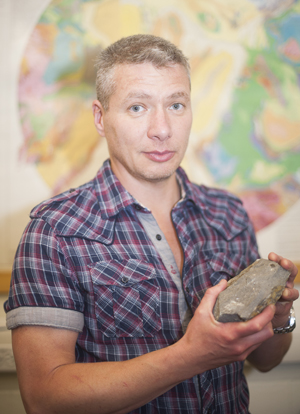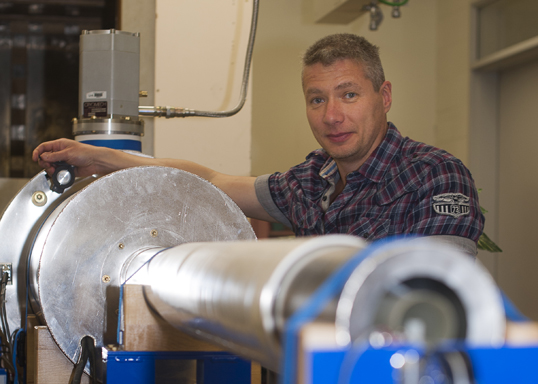While growing up in Russia, Vadim Kravchinsky dreamed of becoming a rock star. But now, instead of guitar chords and distortion pedals, the U of A researcher works with a different kind of rock.
Kravchinsky is at the forefront of paleomagnatism, the study of the magnetic properties of sedimentary rock. Although his work may sound as dull as dirt, it has exciting implications for understanding the geological changes that created-and continue to alter-our environment, and, more lucratively, for finding rich deposits of natural resources beneath the Earth's surface.
To begin to understand what Kravchinsky does, revisit what you learned in elementary school about the Earth's magnetic field: how its magnetism changes at different points around the globe. (Hint: It was the lesson with magnets and pencil shavings.)
Paleomagnetism looks for telltale signs of the Earth's magnetic field imprinted in rock and sediment, then extrapolates knowledge from it about our planet's geology at a particular place and time.
"Studying the magnetic properties of these sediments is like looking at a cassette tape that you have to unwind to see all the component parts," explains Kravchinsky. "Sediments record history layer by layer. Every layer holds the magnetic behaviour of the Earth's geomagnetic field at a certain point in the Earth's history at a specific location."
So, if a sample of sediment does not possess the same characteristics as the location's magnetic field, it must have originated elsewhere and, over time, moved through shifts in the Earth's tectonic plates.
"Recently we have correlated sediments with similar magnetic characteristics that are located in both Africa and North America," he says. "Millions of years ago in time they were located at similar latitude on the Earth."
By applying this information, researchers can understand the environmental conditions humans have faced in our 200,000-year history and create detailed models of the geophysical landscape buried beneath our feet.
"People used to search for oil in the Himalayas," says Kravchinsky. "But by investigating the properties of the rocks in this area and dating them accordingly, we now know it's impossible for that resource to be located in that part of the earth."
Closer to home, companies in western Canada can use Kravchinsky's research to determine the exact locations and amounts of valuable resources such as oil, gold and diamonds.
Determining the magnetic quality of sedimentary rocks demands a highly sophisticated piece of equipment called a cryogenic magnetometer, which takes a minute sample of sediment, reduces its internal temperature to -270 C, and detects the local magnetic orientation by measuring the magnetic flux in each of the three orthogonal directions. The data is then sent to a computer, where researchers can interpret the results.
"With this," says Kravchinsky, patting the cold metal cylinder as if it were a chid, "you can solve the mysteries that are hidden underneath the earth."


We at New Trail welcome your comments. Robust debate and criticism are encouraged, provided it is respectful. We reserve the right to reject comments, images or links that attack ethnicity, nationality, religion, gender or sexual orientation; that include offensive language, threats, spam; are fraudulent or defamatory; infringe on copyright or trademarks; and that just generally aren’t very nice. Discussion is monitored and violation of these guidelines will result in comments being disabled.